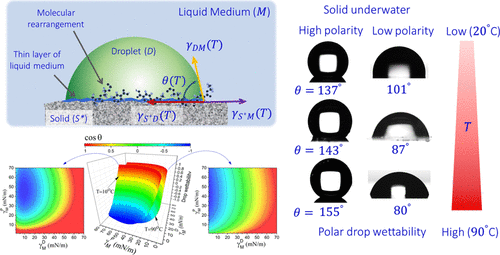Our official English website, www.x-mol.net, welcomes your
feedback! (Note: you will need to create a separate account there.)
New Insights into the Role of the Surrounding Medium Temperature in the Under-Liquid Wetting of Solid Surfaces.
Langmuir ( IF 3.7 ) Pub Date : 2020-06-25 , DOI: 10.1021/acs.langmuir.0c01815 Md Farhad Ismail 1 , Behnam Khorshidi 1 , Mohtada Sadrzadeh 1
Langmuir ( IF 3.7 ) Pub Date : 2020-06-25 , DOI: 10.1021/acs.langmuir.0c01815 Md Farhad Ismail 1 , Behnam Khorshidi 1 , Mohtada Sadrzadeh 1
Affiliation

|
The wetting of a solid surface by a liquid droplet under a liquid medium at elevated temperatures depends not only on the solid-drop and drop-medium interfacial tensions (IFTs) but also on the temperature dependency of the IFT of the surrounding medium. Previous studies have shown either a decreasing or nearly invariant trend of wettability with an increase in temperature. However, much of the research up to now has only focused on the evaluation of solid wettability in air or vapor, and no model has been proposed to predict the variation of solid wettability at high temperatures under a liquid medium. Here, we developed a theoretical framework and a novel experimental approach to evaluate the high-temperature solid–liquid–liquid wettability. We investigated the wettability of different polymeric and nonpolymeric surfaces, namely, glass, silicon wafer, poly(methyl methacrylate) (PMMA), and polytetrafluoroethylene (PTFE), for a wide range of polar and nonpolar probe droplets under water (as a liquid medium) at temperatures up to 90 °C. The experimental results revealed that the nonpolymeric highly polar solid surfaces, that is, glass and silicon wafer, showed a sharp increase in their contact angle with the probe droplets at elevated temperatures. Between the two polymeric surfaces, PMMA showed a decreasing trend of the contact angle over the variation of temperatures, while in the case of PTFE, no specific trend was observed. The predictions of our theoretical model were in good agreement with the experimental observations with less than ±25% deviation.
中文翻译:

周围介质温度在固态表面液体润湿中的作用的新见解。
液滴在高温下在液体介质中对固体表面的润湿不仅取决于固体液滴和液滴介质界面张力(IFT),而且取决于周围介质IFT的温度依赖性。先前的研究表明,随着温度的升高,润湿性下降或几乎不变。然而,迄今为止,许多研究仅集中在空气或蒸气中固体可湿性的评估上,还没有提出模型来预测液体介质在高温下固体可湿性的变化。在这里,我们开发了一个理论框架和一种新颖的实验方法来评估高温固-液-液的润湿性。我们研究了不同聚合物和非聚合物表面(即玻璃,硅片,聚(甲基丙烯酸甲酯)(PMMA)和聚四氟乙烯(PTFE),可在高达90°C的温度下在水(作为液体介质)下用于各种极性和非极性探针液滴。实验结果表明,非聚合的高极性固体表面,即玻璃和硅晶片,在高温下与探针液滴的接触角急剧增加。在两个聚合物表面之间,PMMA随温度变化显示出接触角减小的趋势,而在PTFE的情况下,未观察到特定趋势。我们的理论模型的预测与实验观察结果吻合良好,偏差小于±25%。适用于温度高达90°C的水(作为液体介质)在水中的各种极性和非极性探针液滴。实验结果表明,非聚合的高极性固体表面,即玻璃和硅晶片,在高温下与探针液滴的接触角急剧增加。在两个聚合物表面之间,PMMA随温度变化显示出接触角减小的趋势,而在PTFE的情况下,未观察到特定趋势。我们的理论模型的预测与实验观察结果吻合良好,偏差小于±25%。适用于高达90°C的水(作为液体介质)在水中的各种极性和非极性探针液滴。实验结果表明,非聚合的高极性固体表面,即玻璃和硅晶片,在高温下与探针液滴的接触角急剧增加。在两个聚合物表面之间,PMMA随温度的变化显示出接触角的减小趋势,而在PTFE的情况下,未观察到特定的趋势。我们的理论模型的预测与实验观察结果吻合良好,偏差小于±25%。在高温下,它们与探针液滴的接触角急剧增加。在两个聚合物表面之间,PMMA随温度的变化显示出接触角的减小趋势,而在PTFE的情况下,未观察到特定的趋势。我们的理论模型的预测与实验观察结果吻合良好,偏差小于±25%。在高温下,它们与探针液滴的接触角急剧增加。在两个聚合物表面之间,PMMA随温度的变化显示出接触角的减小趋势,而在PTFE的情况下,未观察到特定的趋势。我们的理论模型的预测与实验观察结果吻合良好,偏差小于±25%。
更新日期:2020-07-21
中文翻译:

周围介质温度在固态表面液体润湿中的作用的新见解。
液滴在高温下在液体介质中对固体表面的润湿不仅取决于固体液滴和液滴介质界面张力(IFT),而且取决于周围介质IFT的温度依赖性。先前的研究表明,随着温度的升高,润湿性下降或几乎不变。然而,迄今为止,许多研究仅集中在空气或蒸气中固体可湿性的评估上,还没有提出模型来预测液体介质在高温下固体可湿性的变化。在这里,我们开发了一个理论框架和一种新颖的实验方法来评估高温固-液-液的润湿性。我们研究了不同聚合物和非聚合物表面(即玻璃,硅片,聚(甲基丙烯酸甲酯)(PMMA)和聚四氟乙烯(PTFE),可在高达90°C的温度下在水(作为液体介质)下用于各种极性和非极性探针液滴。实验结果表明,非聚合的高极性固体表面,即玻璃和硅晶片,在高温下与探针液滴的接触角急剧增加。在两个聚合物表面之间,PMMA随温度变化显示出接触角减小的趋势,而在PTFE的情况下,未观察到特定趋势。我们的理论模型的预测与实验观察结果吻合良好,偏差小于±25%。适用于温度高达90°C的水(作为液体介质)在水中的各种极性和非极性探针液滴。实验结果表明,非聚合的高极性固体表面,即玻璃和硅晶片,在高温下与探针液滴的接触角急剧增加。在两个聚合物表面之间,PMMA随温度变化显示出接触角减小的趋势,而在PTFE的情况下,未观察到特定趋势。我们的理论模型的预测与实验观察结果吻合良好,偏差小于±25%。适用于高达90°C的水(作为液体介质)在水中的各种极性和非极性探针液滴。实验结果表明,非聚合的高极性固体表面,即玻璃和硅晶片,在高温下与探针液滴的接触角急剧增加。在两个聚合物表面之间,PMMA随温度的变化显示出接触角的减小趋势,而在PTFE的情况下,未观察到特定的趋势。我们的理论模型的预测与实验观察结果吻合良好,偏差小于±25%。在高温下,它们与探针液滴的接触角急剧增加。在两个聚合物表面之间,PMMA随温度的变化显示出接触角的减小趋势,而在PTFE的情况下,未观察到特定的趋势。我们的理论模型的预测与实验观察结果吻合良好,偏差小于±25%。在高温下,它们与探针液滴的接触角急剧增加。在两个聚合物表面之间,PMMA随温度的变化显示出接触角的减小趋势,而在PTFE的情况下,未观察到特定的趋势。我们的理论模型的预测与实验观察结果吻合良好,偏差小于±25%。











































 京公网安备 11010802027423号
京公网安备 11010802027423号